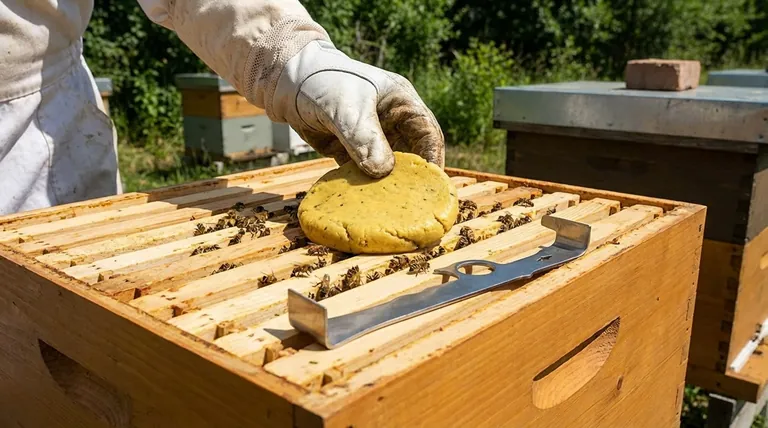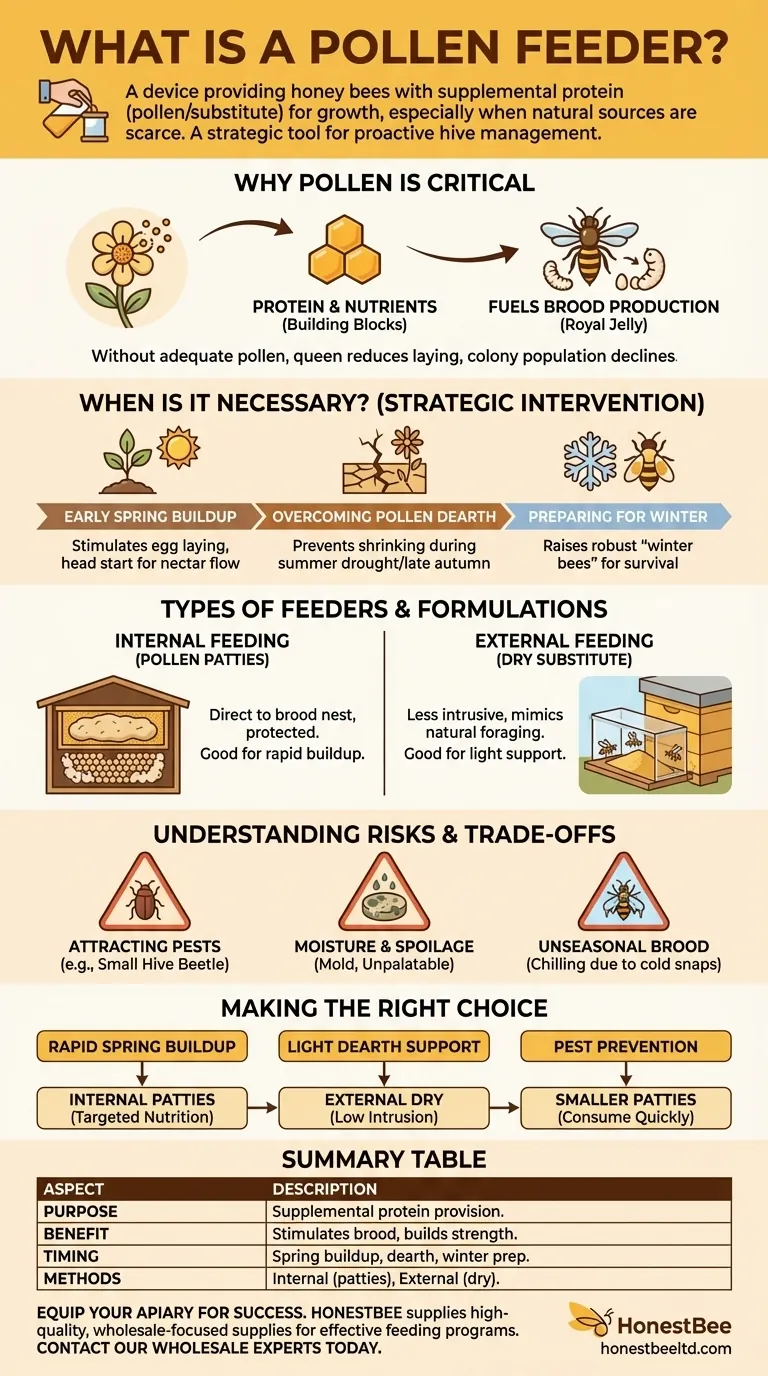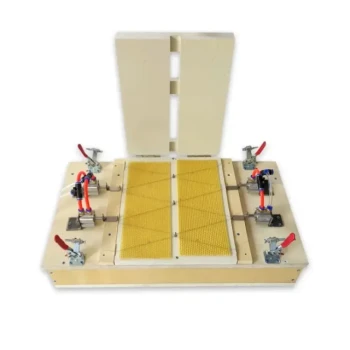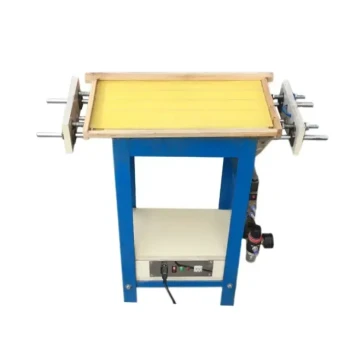In short, a pollen feeder is a device used by beekeepers to provide honey bees with pollen or a pollen substitute. This supplemental feeding ensures the colony has the protein necessary for growth, especially when natural pollen is scarce. The feed can be offered as a dry powder or mixed into a solid patty.
While a pollen feeder is a simple device, its true purpose is strategic intervention. It empowers a beekeeper to provide essential protein to stimulate brood rearing and build colony strength, particularly when natural forage is unavailable.

Why Pollen is Critical for a Honey Bee Colony
To understand the feeder, you must first understand the role of pollen. It is far more than just food; it is the foundation of the colony's future.
The Role of Protein
Pollen is the honey bee's sole natural source of protein, fats, lipids, and essential vitamins. While honey (nectar) provides carbohydrates for energy, pollen provides the building blocks for life.
Fueling Brood Production
Nurse bees consume pollen and convert it into royal jelly to feed the queen, eggs, and developing larvae (brood). Without an adequate supply of pollen, the queen will reduce or even stop laying eggs, and the colony's population will decline.
When is a Pollen Feeder Necessary?
A beekeeper uses a pollen feeder not as a daily tool, but as a specific intervention to overcome environmental challenges.
Early Spring Buildup
Feeding pollen in late winter or early spring, before natural sources are available, stimulates the queen to begin laying eggs. This gives the colony a crucial head start, building a large forager population in time for the main nectar flow.
Overcoming a "Pollen Dearth"
A "dearth" is a period with a lack of nectar or pollen. This can happen during a summer drought or in late autumn after the last flowers have bloomed. Supplemental feeding during a dearth prevents the colony from shrinking.
Preparing for Winter
A final boost of pollen in the fall helps the colony raise healthy, robust "winter bees." These specialized bees have higher fat reserves and live much longer, ensuring the cluster survives until spring.
Types of Feeders and Formulations
The method of feeding is as important as the feed itself, with two primary approaches.
Internal Feeding: Pollen Patties
Pollen patties are the most common method. The pollen substitute is mixed with sugar syrup to form a moist, dough-like cake, which is placed directly on top of the frames inside the hive.
This method delivers nutrition right above the brood nest where nurse bees can easily access it. It also protects the feed from weather and robbing by other insects.
External Feeding: Dry Pollen Substitute
This involves placing dry pollen substitute in a protected feeder several yards away from the hives. Foraging bees collect it like natural pollen and carry it back on their legs.
This method is less intrusive to the hive. However, it is exposed to the elements, can attract pests or bees from other apiaries, and may lead to more waste.
Understanding the Trade-offs and Risks
While beneficial, supplemental pollen feeding is not without its challenges. Acknowledging these risks is key to successful management.
Attracting Pests
Pollen patties, with their high protein content, are highly attractive to hive pests. The Small Hive Beetle, in particular, will readily lay its eggs in patties, leading to a destructive infestation if the colony is too weak to defend the patty.
Moisture and Spoilage
Patties that are not consumed quickly can dry out and become unpalatable, or worse, grow mold. Dry pollen substitute can be ruined by rain or even high humidity, causing it to clump and spoil.
Promoting Unseasonal Brood
Feeding too early in the spring can encourage the queen to lay eggs before the weather is consistently warm enough. A sudden cold snap could cause the cluster to contract, leaving the new brood to chill and die.
Making the Right Choice for Your Goal
The best feeding strategy depends entirely on your specific objective for the colony.
- If your primary focus is a rapid spring buildup: Use internal pollen patties to deliver targeted nutrition directly to the brood nest and maximize consumption.
- If your primary focus is light support during a brief dearth: External dry feeding can be an effective, low-intrusion option, provided you can protect it from weather and pests.
- If your primary focus is preventing a Small Hive Beetle infestation: Use smaller patties or only provide what the bees can consume in a week to avoid giving pests a place to breed.
Ultimately, a pollen feeder is a critical tool for proactive hive management, allowing you to support your colonies when nature falls short.
Summary Table:
| Key Aspect | Description |
|---|---|
| Primary Purpose | To provide supplemental protein (pollen or substitute) to honey bees. |
| Main Benefit | Stimulates brood rearing and builds colony strength, especially when natural pollen is scarce. |
| Common Feeding Methods | Internal feeding with pollen patties or external feeding with dry substitute. |
| Key Timing for Use | Early spring buildup, during a pollen dearth, and for preparing winter bees. |
Equip your apiary with the right tools for success.
Strategic feeding is key to maintaining strong, productive colonies. HONESTBEE supplies commercial apiaries and beekeeping equipment distributors with the high-quality, wholesale-focused supplies needed to implement effective feeding programs.
Let us help you build a stronger operation. Contact our wholesale experts today to discuss your equipment needs.
Visual Guide

Related Products
- HONESTBEE Advanced Ergonomic Stainless Steel Hive Tool for Beekeeping
- No Grafting Queen Rearing Kit: System for Royal Jelly Production and Queen Rearing
- Professional Dual-End Stainless Steel Hive Tool for Beekeeping
- Professional 3-Bar Frame Grip with Integrated Hive Tool
- High Quality Honey Dehumidifier Dryer Thickening Machine for Beekeeping
People Also Ask
- What is a hive tool and what are its uses? Master Your Hive Inspections with the Essential Beekeeper's Tool
- What are the features of a regular hive tool? The Essential Multi-Tool for Every Beekeeper
- How is a hive tool used for scraping and cleaning? Master Hive Maintenance for a Healthy Colony
- What tools are used for cleaning frames? A Beekeeper's Simple 4-Tool Guide
- How should beekeepers handle bees when using a hive tool? Master Calm, Deliberate Techniques



















